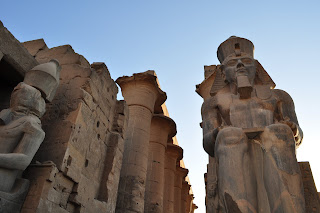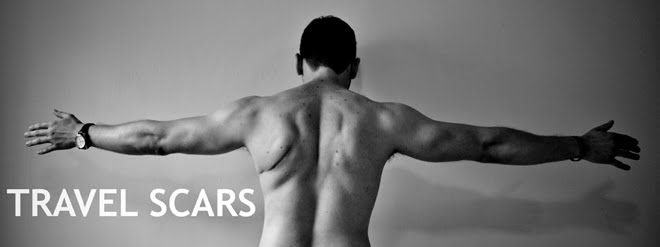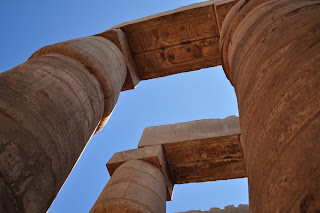Nov. 28th - 30th
We arrived in Luxor after dark. Robert led the way as he was familiar with the city and knew of a great hotel to stay at. A mere five-minute walk led us to the hotel. Once inside, we brought our things to our room. Although not 5-star, this clean, air-conditioned hotel with free breakfast and rooftop terrace cost us a whopping 2.50$ each per night! After another short walk, we had found some food and were content with our new surroundings.
Luxor, the city encompassing the ancient temples and tombs of pharaonic Thebes, is often considered to be one of the world's greatest open-air museums due to the many temples and relics that are still standing within this tourist-haven. Within a ten-minute walk from our hotel, we would pass Internet cafes, jewellery stores, a McDonald's and the 3400-year-old Luxor Temple! I now understand the meaning of juxtaposition.

The following morning, we enjoyed our free breakfast and planned our monumental day. Although Robert had been to this city on numerous occasions, he still decided to take it upon himself and gave us a really unique opportunity to see the fabled Valley of the Kings in a way that very few other tourists do: by foot. A vast majority of tourists that visit Egypt come in prepackaged tours, with their scheduled itineraries, organized routes and of course, air-conditioned coaches. These large buses escort them from one temple's parking lot to another, often giving the passengers just enough time to snap a few pictures before speedily continuing on their whirlwind program. We on the other-hand, could take our time.
We walked to the Nile and hopped on the first public ferry leaving to the west bank of the river. Once across, we stopped at the nearest convenience store and picked up some hiking essentials. Chris and I grabbed some Doritos, cheese and some sweets. Robert had recommended that we try some Hostess Ho Hos. I had never tried them, but the fact that I could purchase a dozen of them while spending hardly over a dollar made their worth that much more apparent.
From the west bank of the Nile, to the first archaeologically significant site, was spent walking along the side of the road. We made sure to walk against traffic in order to see oncoming cars and to prevent every cab, rickshaw and microbus driver from pulling over and propositioning to give us a ride. Although there was no shoulder to this two-lane road, it still didn't stop eager cabbies from making their attempted sale anyways.
The near hour-walk finally led us to our first monolithic encounter: the Colossi of Memnon. These two massive structures depict Pharaoh Amenhotep III and served to guard the mortuary temple of the aforementioned Pharaoh. While mostly in ruin, the sheer size of these 700-ton statues is still quite impressive. We admired the statues for a few minutes, while waiting for the many luxury coaches to pack-up and continue on towards the Valley of the Kings, so that we could take some unencumbered photographs. The tranquility only lasted a few seconds before the next wave of crowded buses arrived at the site.


We continued towards the mountainous landscape in the distance, passing the remnants of an ever receding village that lies at the edge of the tombs. Many treasures and significant archaeological discoveries have been made all throughout the region, including beneath many of these homes, explaining their occupants' gradual expulsion from the area. Not to mention, Robert stated that many grave robbers have also sought residence in these houses for that very same reason!

We continued to follow the road until Robert motioned for us to veer left and start our ascent up a gravel path. As we climbed, the magnitude and extent to which we would be witnessing this incredible necropolis was soon becoming apparent. To our right, we could see the tomb complex of the workers, the artists and sculptors who actually toiled away for countless years creating the extravagant tombs for the Nobility, Kings and Queens. One can imagine that those responsible for the intricate artisanal workings of the magnificent royal tombs would not be content with shoddy, minimalist tombs for themselves. Therefore, it is said that many of the workers tombs rival their pharaonic masters' in terms of artwork and beauty. There's even a mini pyramid!


After another few hundred meters, we could now see the Valley of the Queens to our left. Although now clearly distinguishable due to the parking lot located at it's entrance, it once served as the hidden resting place of Egypt's Queens, Princes and Princesses. In fact, all of the Theban Necropolis' tombs were meant to remain hidden: despite the grandeur and magnificence of the tombs of Egypt's Old Kingdom; the fact that untold treasures and incalculable wealth lay buried beneath a pyramid measuring several hundred feet tall, made them ridiculously easy targets for grave robbers! Egypt's New Kingdom however, thought they would outsmart the would-be grave robbers and bury the deceased Pharaohs and their wealth beneath the unassuming hills surrounding Thebes (modern day Luxor).


The New (well relatively-speaking) Egyptians didn't entirely forget the significance of pyramids to their dead ancestors, and coincidentally enough, had a natural pyramid forming the apex of the nearby hills in the vicinity of their capital city. This pyramidal peak is known as Al-Qurn, and served as our reflective, photo-opportunistic, and Ho Hos gorging point.

After refueling, we continued on the ridge overlooking the numerous mortuary temples and started our descent towards the valley of the kings. What is truly incredible is how novel this way of visiting the Theban necropolis is and yet, how few people do it. Walking through these hills, we did not pass a single other traveller the entire afternoon, and this is one to the most visited sites in all of Egypt!

The last temple we would be passing over was that of Queen Hatshepsut. Although nothing to look at from above; a side or front view of this temple reveals one of the most iconic images in all of Egypt. Although I had never heard the name before, as soon as I saw it, my mind was flooded with the every article of Egyptian media ever presented to me. When Robert had asked us what we wanted to see in Luxor, it was this temple that I had described to him. We climbed over a sign that said 'Do not enter' and proceeded down a path used by soldiers guarding the historic landmarks, to catch a better glimpse of this impressive shrine.


The sun was quite low in the sky by the time we had reached the Valley of the Kings. Taking this path, we actually bypassed the initial gate and as a consequence I didn't need to check-in my camera. They do this to prevent people from taking pictures in the tombs for preservation purposes, so I just hid it in my backpack and abstained from taking pictures nonetheless. Since Chris and I had no preference to which tombs we would visit (they only allowed three tombs per ticket purchased), we allowed Robert to choose and give us their historical background.

It is pretty sad that I do not remember the names of the tombs we had visited, although I know one of them was Rameses IX, because Robert had told us that all tourists visit this one. It is also possible that we visited Rameses VI and Thutmose III, but I am just basing it on the descriptions given on tourist websites. Either way, the artwork in the tombs we visited was incredibly detailed and elaborate. Although each tomb's style was quite diverse, each was beautiful in their own distinct way. After providing one of the guards a little baksheesh, or gratuity in Arabic, which can pretty much allow you to do whatever you want in Egypt, we were let into a fourth tomb, despite only technically having permission to enter three.
After leaving the Valley of the kings, our walk back to the west bank of the Nile was long and at some points, involved us traipsing through a field and perhaps even an archaeological sight. We got lost, it was dark. After nearly walking for what seemed close to 2 hours, a microbus finally passed and took us the rest of the way. That evening, Chris and I walked to the now glowing Luxor temple and sat nearby, once again marveling at it's resplendence and conflicting proximity to the golden arches (not another monument but Mickey D's).

After sitting for a few minutes, we were approached by a man with a glorious mustache and Jheri curls that would make the 80s jealous. He introduced himself and asked if he could join us. We agreed, but due to our extensive walk that day, our meeting would be rather brief. He invited us for tea, we kindly obliged but made our exit once we had finished. He then asked us to join him for a beer. We declined but said we would meet him tomorrow and indulge when we weren't so tired.
The following day, we woke up late and enjoyed our complimentary breakfast and coffee. Unfortunately, it would be Robert's last morning in Luxor. He was continuing north towards Cairo and Alexandria. We thanked him immensely for giving us our unique necropolis experience and bid him safe travels. Before making our way to the day's ancient temple, we stopped at a convenience store and picked up some bottled water and Robert's sugary legacy: Ho Hos. From there we walked to the Karnak temple complex, the mother of all temples.

Karnak is the largest ancient religious site in the world. Its temples, columns, obelisks, statues and architecture are absolutely magnificent. You could spend days exploring this massive complex. It's construction was started by Ramses II and was dedicated to the god Amun. Rather than writing about it's many sculpted wonders, I will instead just provide many photos for your viewing pleasure.






That evening, Chris and I returned to Luxor temple and met the Egyptian man who had talked to us the night before. Although I do not remember his name, what we discussed was a rather eye-opening experience. This man worked in the tourist industry in the Russian-infested, Red Sea beach resort town of Hurghada. Although he worked with tourists and was an Egyptian, he claimed that it was very difficult for him to travel within his own country. Permits are usually required for Egytians to travel to various areas, and depending on the tourist concentrations, can be next to impossible. Due to the country's dependence on tourism for a large percentage of its economy and employment, they do not want this industry to suffer.
As I had previously mentioned, we had to travel by police-escorted convoy to reach Abu Simbel and ' Tourism Police' can be found almost everywhere, ensuring that no tourist is being excessively harassed or bothered. The reason for these measures is the two major terrorist attacks: The Luxor Massacre in 1997, killing 59 foreign tourists and the 2005 Sharm el-Sheikh attacks, killing up to 88 people. Both these events crippled the tourism industry, for obvious reasons, and it took Egypt several years to recover following these two tragedies. As a result, we as tourists, had more freedom and accessibility to Egypt's many regions than many of its citizens. Many Egyptians were fed up with these restrictions and I can understand why, a mere month later, the discontent with the government culminated into what is now known as the 2011 Egyptian Revolution, resulting in the removal of the president, Hosni Murabak.
After sitting at Luxor temple, we made our way to a bar which the man we were with raved about. As we entered, the bouncer checked and held onto our Egyptian friend's ID, only returning it when we left. The bar was similar to the one we went to in Aswan: old men sitting, sipping on their beers, often sitting alone and chain-smoking cheap cigarettes. The only women present were the two waitresses who seemed rather ecstatic to see non-Egyptians in their establishment. Despite my prior impression that Egypt may have a thriving bar and club scene, the dreary, often depressing examples which we had been exposed to seemed to invalidate my theory. We finished our beers and made our way back to our hotel.
It was now our final day in Luxor, and we decided to return to the west bank of the Nile. Lonely Planet had rated the Ramesseum as one of the must-see temples in Egypt, so we decided to check it out. The Ramesseum is the mortuary temple of my now favourite Pharoah, Ramesses II, the same one responsible for Abu Simbel and Karnak among other amazing structures throughout Egypt. We spent the early afternoon wandering around the temple and admiring the many colossal statues constructed in his likeness.




After, we returned to Luxor and while Chris opted to head back to the hotel, I decided to explore the interior of Luxor temple. To be honest, I thought that the Luxor temple was one of the most impressive I had seen, with its many obelisks, statues and numerous sphinx lining an ancient road towards Karnak.



I spend nearly an hour admiring the many corners of this beautiful temple. Another amazing aspect to this temple is that a beautiful mosque, the Abu el-Haggag, was built just above the ruins and the contrast between pharaonic and Islamic Egypt was absolutely stunning.

I then returned to our hotel and watched the sunset as it dipped over this magical and ancient city. Chris and I had purchased a train ticket to Alexandria that would be departing in a few hours. It was actually a ticket that the hotel owner had to procure for us because tourists were not allowed to buy them for nonexistent security reasons.

Later that evening, as we waited for our overnight train, it dawned on me that upon our arrival to Alexandria, we would have achieved our goal of longitudinally traversing the African continent, from the southern tip of South Africa to the Mediterranean Sea!
We made it.




These pics are seriously amazing James.
ReplyDelete